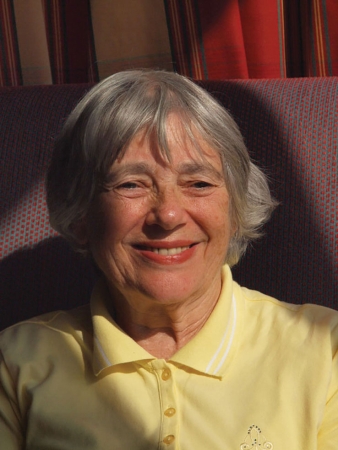
Helga Pollak was born in Vienna on May 28, 1930 to Otto and Frieda (née Meisel) Pollak. Her father came from Kyjov from where he moved to Vienna. In 1916 he joined the army, got injured seriously and lost one leg. When he came back to Vienna, he opened a musical cafeteria called Palmhof at Mariahilferstrasse together with his brother Karel (1919).
When Austria was occupied by Germany, Palmhof was closed, aryanized and served further as a casino. The parents divorced and Helga stayed with her father, mother used to visit her there every day. The Nuremberg racial laws came into force in Austria. Helga had to sit in a desk for Jews, children were turning away and the girl looked forward to the holidays in Kyjov. In the house no. 33 on the Kyjovské Square (the present culture house) Helga’s grandmother Sophie used to live, together with her aunt Marta (father’s sister), uncle Fritz and their children Truda and Joschka. The situation in Austria was dangerous for Helga, therefore the parents divorced and decided to sign her up for German school in Brno. First she stayed at a boarding house, then with the foster family of Wittmann but he felt as a total stranger. She fi nally came back to Kyjov to her relatives and, despite she could not speak Czech ad had to repeat the second grade, she signed up for a Czech school. The feeling of happiness and safety was terminated by “Munich Agreement”. The Nazis established on 21st June 1939 in the Protectorate of Bohemia and Moravia the Nuremberg racial laws, the same as in Austria some time before that. Helga was caught by her destiny for the second time. There was a certain hope for her to leave the protectorate and go to England where Helga’s mother was already waiting for her.
The girl’s departure was crossed by the beginning of World War II. So she fi nished the third grade in Kyjov and then was – for the second time already – taken from Brno – that time to a Jewish school (the only school she was allowed to visit). When in spring 1941 an order was issued in the protectorate banning the Jewish from travelling, Helga returned to Kyjov. Otto Pollak who still lived in Vienna at that time applied for permit to emigrate into the protectorate which he was granted on September 2, and arrived to Kyjov on September 9. On the freezing 17th January 1943 Helga starts writing her diary. Her fi rst words are: “I am spending my last day in Kyjov which is full of rush. We are packing food in bags and knapsacks. In 12 hours the apartment will be abandoned…” The train from Kyjov set off for the journey and arrived to Bohusovice on Friday morning on January 23, 1943. In about one hour walk, little Helga entered the ghetto of Terezin. Soon after the arrival she was placed in a girls’ house L 410, second fl oor, room number 28. At the beginning, Helga was very reserved and got help from her father who was placed in the house for war invalids. This, by the way, saved him from the transports. However, Helga got to one of those. It left Terezin on October 23 1944, heading for Auschwitz. The Auschwitz selection is a bad memory of Helga when doctor Mengele, yet unknown to her, came, and the girls had to run in reverse around him, hands up and naked. He selected out the pregnant, old and skinny ones. The entire day they had to stand in columns of fi ves and wait. At the end, she left with the transport to a factory in Oederan (Saxony). With the approaching front, Helga was put together with the others to a transport which took her back to Terezin. Women arrived there in miserable condition, half-dead with hunger and exhaustion. They were about to wait long days in quarantine.
From Helga’s diary
April 29, 1945: “The news that SS had to leave the town within 48 hours spread across the ghetto.” May 3: “The International Red Cross took over the ghetto and small fortress.” May 4: “Soviet tanks and armoured carriers appeared, (…) and the Czech gendarmerie arrived to the town with a Czechoslovakian fl ag, (…) still new transports of prisoners are coming from the east, (…) starvation in the buildings continues.” May 7: “Almost all inhabitants of Terezin gathered last night on the main square where they learned with fi nal validity that Germany surrendered unconditionally.”
When released from the quarantine, Helga refused the off er for recovery in Switzerland and, together with her father and cousin Trude, who survived the Bergen-Belsen concentration camp, returned to Kyjov. However, the other sixty three relatives of Otto Polak never made it back. Only next year Helga met her mother in England where she fi nally got to study. In 1951 she got married and followed her husband Kinsky to Thailand and Ethiopia. Finally they came back to Austria in 1957 with their two children. The Helga Pollak’s diary became the testimony of the life in Terezin, and served the Czech-American director Susan Justman to record a fi lm titled “Terezin Diary” (1988) and “Voices of the Children“ (1997). Later it was transformed to theatre adaption in the Freiburg theatre, and the book “Girls From Room 28” was translated to Czech. Helga Kinsky keeps on travelling around the world, bearing the testimony of holocaust to people.
For the Terezín Memorial Luděk Sládek, foto © Helga Kinsky
Nesouhlas se zpracováním Vašich osobních údajů byl zaznamenán.
Váš záznam bude z databáze Vydavatelstvím KAM po Česku s.r.o. vymazán neprodleně, nejpozději však v zákonné lhůtě.